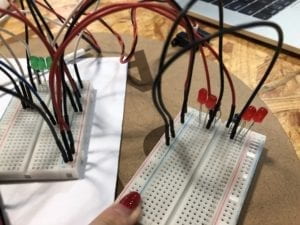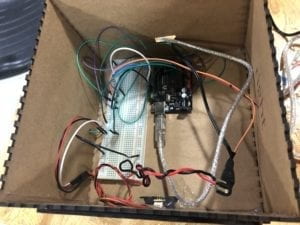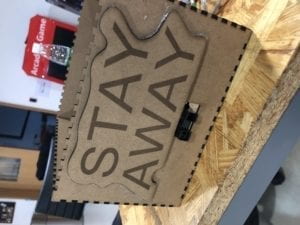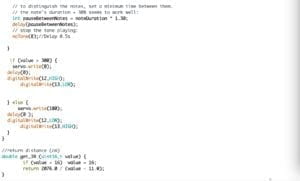In the previous research, I found that interaction should be a mutual process that one responds to the action of another. No matter the process is only one cycle or more, nor who the initiator is. It requires the participation of at least two actors. In all the projects I’ve researched, I think the response from the machine is extremely important, for it shows people that the machine has received the information and is responding to it.
So when we first started to design our project, we decided to build a machine that uses a sensor to detect people’s approach and then reacts to it. It would send the message that they should stay away from it by lighting up the red lights when they get closer, and lighting up the green lights when they are far enough. However, we later found this device was too simple and required more improvement during the User Testing Session. We got a bunch of valuable advice and questions, such as LED was too unobvious, we should add something to make it more complicated, under what circumstances would it be used, what purpose it serves. It made us realized where we could still improve and where the problems lied, so we reflected on the original version and did a lot of adjustments after that session. Since Halloween is coming, we decided to make it a special device for this festival. It is a fun and easy-to-use device intended for kids to celebrate Halloween and bring more horror vibe. All you need to do is to place it somewhere that people would walk past.
We printed a scary image of a clown and attached it to a servo motor, so it can pop up when people come closer and surprise them. The image is black and white instead of full-color, as we thought it might be scarier this way. We also added a player to play strange music to make it more creepy and draw people’s attention. We kept the LEDs stuck to both sides of the box and they served the same purpose. The code was changed accordingly. We used laser cut to make the wooden box and the big stay-away sign and put all the wires and breadboard inside the box to make the device look neater. We didn’t choose the transparent one because people could still see all the wires and they might find the clown before it pops out if the box was transparent.
 the original version
the original version


In our expectation, the device using the sign and the music to attract people to come closer, and when people come, the device responds by popping out the clown. So the device is the initiator, sending out information, and people receive it and react. Then the device processes it by collecting data from the sensor and responds to it. It is a cyclical and mutual process. We stuck the sign onto the box to make its purpose obvious—stay away from it, but with the creepy music, the sign may have an opposite effect. Though people are told to stay away, they may be attracted by the sound, and their curiosity will lead them closer to the device. Also, some people tend to do what they are told not to, so they may still go closer to see despite the warning. When the sensor detects they getting closer, the clown will pop out and people will be surprised and scared.
Our goal was to build a device that can interact with people by creating a process that happened between the device and people, and I think this device has achieved it. It aligns with the definition because it can create such a process—it in a way asks people to come closer and then responds to people’s approach. I’m proud of what we build. Though during the presentation it didn’t work well, it reacted slowlier and was less sensitive than the last time we tested it. So the user was a little confused. If given more time, we want to add more details to it. Adding different sounds according to the changes of the distance and decorations would make it better. If the clown can pop out faster and more suddenly, it would be scarier.
From this experience, I’ve found that user experience is extremely helpful and important. It helps you to know your defects and how you can improve them. When doing something, we should take users’ opinions into consideration. And cooperation is essential too. This project is a combination of both of our efforts. I’ve learned that even though we might not do well for the first time, we can keep improving it till the last minute.

